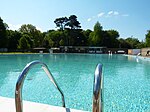Church of St John sub Castro, Lewes
19th-century Church of England church buildingsChurch of England church buildings in East SussexChurches completed in 1839Gothic Revival architecture in East SussexGothic Revival church buildings in England ... and 2 more
Grade II listed churches in East SussexLewes

The Church of St John sub Castro is an Anglican church in Lewes, the county town of East Sussex, England (grid reference TQ 414 104). It was built in 1839 on the site of an 11th-century Saxon church, and has been designated by English Heritage as a Grade II listed building. In the churchyard is a memorial to Finnish prisoners from the Crimean War who died while confined in Lewes Naval Prison; the memorial is also listed Grade II. The church continues to be active as a parish church in the diocese of Chichester.
Excerpt from the Wikipedia article Church of St John sub Castro, Lewes (License: CC BY-SA 3.0, Authors, Images).Church of St John sub Castro, Lewes
Church Row,
Geographical coordinates (GPS) Address External links Nearby Places Show on map
Geographical coordinates (GPS)
| Latitude | Longitude |
|---|---|
| N 50.876 ° | E 0.0094 ° |
Address
St John Sub Castro
Church Row
BN7 2PU , The Pells
England, United Kingdom
Open on Google Maps











